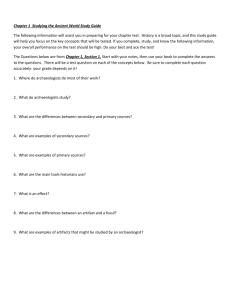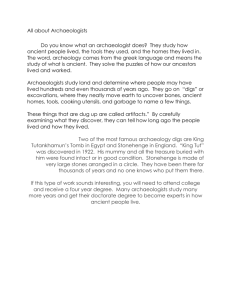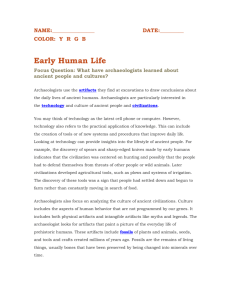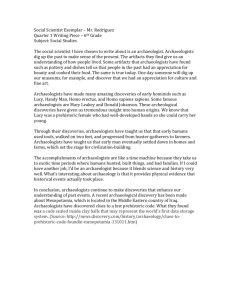Archaeology packet
advertisement
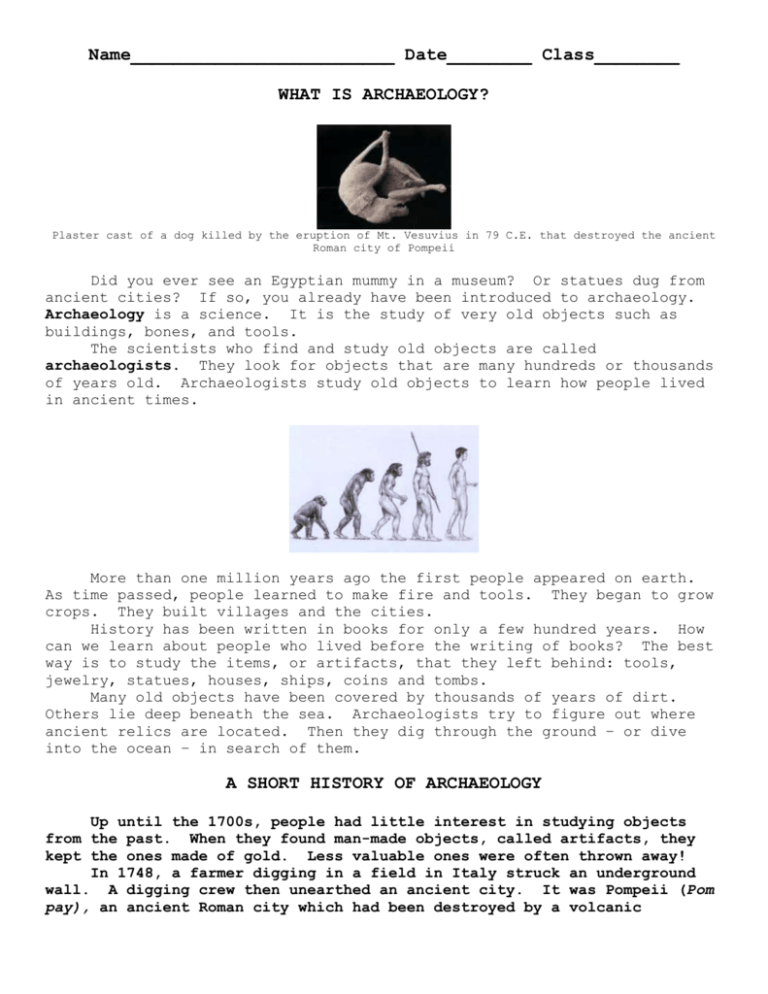
Name_________________________ Date________ Class________ WHAT IS ARCHAEOLOGY? Plaster cast of a dog killed by the eruption of Mt. Vesuvius in 79 C.E. that destroyed the ancient Roman city of Pompeii Did you ever see an Egyptian mummy in a museum? Or statues dug from ancient cities? If so, you already have been introduced to archaeology. Archaeology is a science. It is the study of very old objects such as buildings, bones, and tools. The scientists who find and study old objects are called archaeologists. They look for objects that are many hundreds or thousands of years old. Archaeologists study old objects to learn how people lived in ancient times. More than one million years ago the first people appeared on earth. As time passed, people learned to make fire and tools. They began to grow crops. They built villages and the cities. History has been written in books for only a few hundred years. How can we learn about people who lived before the writing of books? The best way is to study the items, or artifacts, that they left behind: tools, jewelry, statues, houses, ships, coins and tombs. Many old objects have been covered by thousands of years of dirt. Others lie deep beneath the sea. Archaeologists try to figure out where ancient relics are located. Then they dig through the ground – or dive into the ocean – in search of them. A SHORT HISTORY OF ARCHAEOLOGY Up until the 1700s, people had little interest in studying objects from the past. When they found man-made objects, called artifacts, they kept the ones made of gold. Less valuable ones were often thrown away! In 1748, a farmer digging in a field in Italy struck an underground wall. A digging crew then unearthed an ancient city. It was Pompeii (Pom pay), an ancient Roman city which had been destroyed by a volcanic eruption in 79 C.E., nearly 1,700 years earlier. The excavation (or digging) at Pompeii was one of the first done in an organized way. Even so, archaeologists of the 1700s still mainly sought treasure. They tossed aside many other artifacts in their search for it. Sir Flinders Petrie (1853-1942)was one of the first archaeologists to study everything he found. Petrie worked in Egypt during the late 1800s. When Petrie dug, he searched the earth “inch by inch,” as he described it. Petrie found pottery, tools, and other items used by the Egyptians in their daily life. Because he worked so carefully, Petrie is called the “father of Modern Archaeology.” Today’s archaeologists use the “inch by inch” method. They keep detailed records of everything they find. They know that the smallest artifact can help us understand how ancient people lived. FAMOUS DISCOVERIES As a boy, Heinrich Schliemann (1822-1890) liked stories about ancient Greece. He loved the Illiad, a story by the Greek poet Homer. It tells of the war between the Greeks and the people of Troy. O on knew where Troy had been located and some people even thought it was a fictional place. Schliemann decided that one day he’d find this lost city. Bust of the Greek poet Homer Legendary Trojan Horse When Schliemann was forty-two years old, he began to search for Troy. Schliemann studied the Illiad. He decided the city was located near the Aegean Sea in what is now Turkey. He went there and began to dig. In the early 1870s Schliemann found the ruins of Troy. It was one of nine cities built on top of each other. Ancient Greece Another big find occurred in 1799. That year a French soldier found a stone tablet in Egypt. On the stone was ancient Egyptian writing called hieroglyphics. Because the tablet was found near the modern-day village of Rosetta, it was named the Rosetta Stone. The message written in hieroglyphics was also written in Greek. The writing system used by the ancient Greeks is a well-known language. The French archaeologist Jean Francois Champollion (1790-1832) studied the tablet. First he translated the Greek. From that he was able to figure out the hieroglyphics after many years of study. In this way he was able to crack the code of the ancient Egyptian language and made it possible for archaeologists to read many more of the writings that were recorded by the ancient Egyptians including business records, myths and even love songs. In the early 1900s Howard Carter (1873-1939) searched for a tomb in Ancient Egypt. In 1922, he found it. In the tomb were many items belonging to Tutankhamen (toot ankh amen), a king who lived more than 3,300 years ago. Carter also found the mummy of “King Tut.” Howard Carter and the mummy of Tutankhamen DISCOVERIES BY CHILDREN Children have made important archaeological finds as well. For example, in 1870, a man and his nine-year-old daughter entered a cave at Altamira, Spain. The two had often explored this cave near their home. As her father dug for tools and bones, Maria Sautuola became bored. She took a candle and went to a corner of the cave. Looking up at the ceiling, Maria saw paintings of animals. The cave paintings – made more than 12,000 years ago – are among the oldest art works ever discovered. In the summer of 1947, a shepherd boy, Mohammed Adh-Dhib, was tending goats in Palestine. One goat got lost. Mohammed climbed a hill to find it. On top of the hill Mohammed spotted a cave. He returned to the cave the next day with a friend. Inside, they found parts of the Bible written nearly two thousand years ago. Dead Sea Scrolls Other parts of the Bible were later found nearby. Because they were found near the Dead Sea, these manuscripts are called the Dead Sea Scrolls. KNOWING WHERE TO LOOK The world is a big place. How do archaeologists know where to look for ancient relics? They don’t just guess. Like detectives, they search for clues. Old books and writings often provide good clues. The Bible, the works of Homer, and other old manuscripts describe ancient towns. Some of those towns are still there – buried under layers of dirt. Archaeologists study the books to determine where the ancient sites may be located. Archaeologists will also listen to the stories that people tell about past events. These stories are part of a culture’s oral tradition and includes the myths, legends and beliefs that are passed down from one generation to another. For example, people may tell of a sunken ship. Archaeologists listen to such stories for clues about a ship’s location. Archaeologists may also us photographs taken from airplanes to help them find locations to excavate. Photographs taken from airplanes can help them see what they cannot see from the ground. For example, an aerial photograph may show that a piece of land is more fertile (better for growing) than a nearby piece of land. This may be because ancient people worked the soil there. Archaeologists have many other tools to help them decide where to work. DIGGING It can take many lifetimes to excavate a site. Archaeologists have been digging at Pompeii since 1748. That’s over 150 years and there is still much work to be done there. Because digging takes so long, archaeologists hate to waste time. Excavation continues at Pompeii When they’ve found a likely holes that show how far down the These show how long and wide the site, archaeologists hire a crew site, they sink trial shafts. These are site goes. They also dig trial trenches. site is. Once they know the size of the and organize the digging. Pictures are taken of any objects the crew finds. The an archaeologist carefully removes the artifact from the ground with a little knife or brush. HOW OLD IS IT? Once archaeologists have found an artifact, they have several questions. A main one is: How old is it? Knowing the ages of artifacts helps chart the growth of civilization. The archaeologist Christian Thomsen (1788-1865) worked out the Three Age System that is still used today. The three ages are the Stone Age, the Bronze Age, and the Iron Age. Stone arrow heads The Stone Age was the first in the Three Age System. The Stone Age was when people used stone tools. It began over a million years ago and ended about five thousand years ago (lasted about 995,000 years and ended around 3,000 B.C.E.). During the Bronze Age people made tools out of the metal bronze. It extended from about five thousand years ago to around three thousand years ago (lasted about 2,000 years and ended around 1,000 B.C.E.). The Iron Age began about three thousand years ago (around 1,000 B.C.E.). We are still living in the Iron Age. How do you think the Iron Age earned its name? By learning what an artifact is made of, scientists obtain a very rough idea of its age. They also have ways to learn its age more exactly. One important method is called carbon-14 dating. When a living thing dies, it gives off a substance called carbon 14. The longer an object has been dead, the less carbon 14 it has. By measuring the amount of carbon 14 in a piece of wood or other object that was once alive, scientists can tell its age. Carbon-14 dating only works for objects that lived within the past 40,000 years. Scientists have other methods to date objects older than that. Carbon 14 ALL KINDS OF ARCHAEOLOGISTS There are other kinds of archaeologists besides those who dig for artifacts. Some translate old writing. Others work in museums. Governments archaeologists make sure that old sites aren’t destroyed. Many archaeologists teach. One good teacher can train hundreds of future archaeologists. Many finds are yet to be discovered by archaeologists. Sunken ships still lie underwater. Lost cities still lie beneath the ground. Statues, caves and mummies wait to be found. Writing tablets need to be translated. Perhaps you will become an archaeologist. Then you will help our human race to learn more about our past. A.D. – this refers to the years after the birth of Christ aerial photographs (AIR ee il) - pictures taken from the air amateur (AM ah cher) – one who does something without pay ancient (AIN chent) – very old archaeologist (are kay OL oh gist) – a scientist who studies very old objects archaeology (ar kay OL uh gee) – the scientific study of very old objects including buildings, bones, tools and art works artifacts (AR tih facts) – objects made by people of long ago B.C. – this refers to the years before Christ was born Bronze age(BRAHNZ) – the period starting about 5,000 years ago and ending about 3,000 years ago, when people made bronze tools carbon-14 dating (CAR bun) – a method to tell the age of old objects that were once alive excavation (ex kah VAY shun) – the process of digging expedition (ex ped DIH shun) - a trip made by a group for scientific study fertile (FER till) – good for plants to grow in hieroglyphics (hy roh GLIH fix) – picture writing used by Egyptians, Aztecs, and several other peoples Iron Age – the period, starting about 3,000 years ago and continuing to this day, when tools have been made of iron magnets (MAG netz) – objects that attract certain materials manuscripts (MAN yoo scripts) – written or typed materials metal detectors (MEH til dee TEK torz) – devices used to locate old coins and other metal objects mound – a hill built by people mummy (MUM ee) – a dead body specially treated so that it will last for thousands of years museum (myoo zee um) – a building where art works or historical materials are shown to the public relic – an object left from the past Rosetta Stone – (ro ZET ah) – an ancient tablet that helped scientists translate Egyptian hieroglyphics site (SYTE) – location of something Stone Age – the period, starting over a million years ago and ending about 5,000 years ago, when people mad stone tools Three Age System – a system in which human history is divided into the Stone, Bronze, and Iron ages tomb – (TOOM) – a place where a dead person is put translate – (TRANZ late) – to convert the words of one language into the words of another language trial shafts – (TRYL SHAFTZ) – holes dug to find how far down a site goes trial trenches – cuts made in the ground to determine how far across a site extends trowel (TROWL) – a little shovel used for digging
